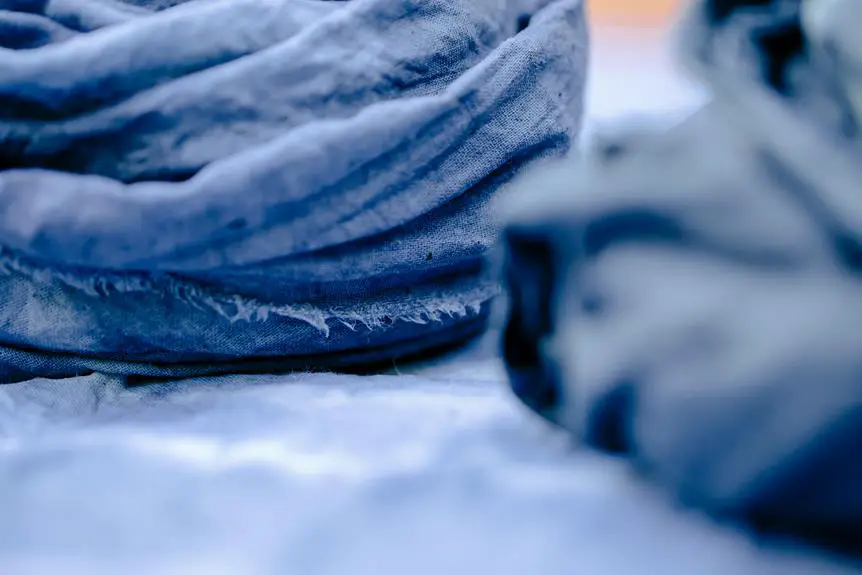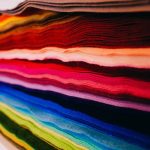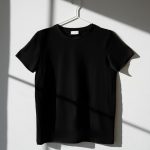When you decide to dye broadcloth fabric, the first step is choosing the right dye for your specific material, whether it's cotton or polyester. You'll want to prepare the fabric properly by washing and ironing it to create an ideal surface for dyeing. Setting up your workspace is equally important, as it ensures a smooth process. But what about the different dyeing techniques you can explore? Understanding these methods can significantly impact your final result, and there are some nuances that could make all the difference in your project.
Table of Contents
Choosing the Right Dye
When choosing the right dye for your broadcloth fabric, consider the fiber content and the desired color outcome. Broadcloth is typically made from cotton, polyester, or a blend of both, and each fiber type requires a specific dyeing method.
For 100% cotton broadcloth, fiber-reactive dyes work best, as they bond well with the fibers and produce vibrant colors. If your fabric contains polyester, you'll need to use disperse dyes, which require higher temperatures to properly adhere to the synthetic fibers. Always check the dye's label to ensure it's compatible with your broadcloth's fiber content.
Next, think about the color you want. Different dyes yield varying results based on the fabric's original shade. If you're aiming for a bold hue, consider starting with a white or light-colored broadcloth. For a subtler tone, darker fabrics can work, but they may require more dye for a noticeable change.
Lastly, don't forget to test your dye on a small fabric swatch. This way, you can see how the dye reacts and ensure you're happy with the color before dyeing the entire piece.
Preparing Your Broadcloth
To prepare your broadcloth for dyeing, start by washing it to remove any finishes or impurities that could affect the dye's absorption. Use a mild detergent and warm water to give your fabric a thorough cleaning. After washing, rinse it well to ensure all detergent residues are gone. This step is crucial because any leftover finishes can prevent the dye from adhering properly.
Next, dry your broadcloth. You can either air-dry it or tumble dry on a low setting, depending on the fabric's care instructions. Make sure it's completely dry before you move on to dyeing. If your broadcloth is wrinkled, iron it on a low setting to smooth out any creases; this will help ensure an even dye application.
Once your fabric is clean and dry, check it for any repairs that might be needed. Any small tears or holes should be mended before you dye, as they can become more pronounced after the dyeing process.
Now your broadcloth is prepped and ready for the exciting part—dyeing! Following these steps will help you achieve the best results.
Setting Up Your Workspace
Start by clearing a dedicated area where you can comfortably dye your broadcloth without any distractions or mess. A well-organized workspace not only enhances your efficiency but also helps you avoid accidents. Here's how to set it up:
- Choose a Suitable Surface: Use a table or countertop covered with plastic or old newspapers to protect it from dye spills.
- Gather Your Supplies: Collect all necessary items like dye, gloves, measuring cups, and stirring sticks. Having everything at hand prevents interruptions.
- Ensure Proper Ventilation: If you're using chemical dyes, work in a well-ventilated area or near an open window to avoid inhaling fumes.
- Prepare Water Access: Make sure you have easy access to hot water for mixing your dye. A nearby sink can be very helpful.
Dyeing Techniques to Consider
There are several effective dyeing techniques you can use to achieve vibrant colors on broadcloth fabric.
One popular method is immersion dyeing, where you fully submerge the fabric in a dye bath. This technique ensures even color distribution, making it perfect for solid colors. Just make sure to prepare your dye bath according to the dye manufacturer's instructions.
Another technique is tie-dyeing, which allows you to create unique patterns. You can twist, fold, or bind the fabric with rubber bands or string before applying dye. By doing this, you'll achieve stunning designs that make your broadcloth stand out.
If you prefer more control over the color application, consider using a spray or sponge technique. This method works well for creating gradient effects or splatter designs. Simply dilute your dye with water and apply it using a spray bottle or sponge.
Lastly, batik is a wax-resist dyeing technique that gives your fabric a distinctive look. You apply melted wax to areas you want to remain undyed before dyeing the entire piece. Once the dye sets, remove the wax, revealing beautiful patterns.
Choose the technique that best suits your creative vision!
Rinsing and Washing
After dyeing your broadcloth fabric, rinsing and washing it properly ensures that the colors set well and any excess dye is removed. This step is crucial to maintain the vibrancy of your fabric without risking bleeding when you wash it later. Here's how to do it effectively:
- Cool Rinse: Start by rinsing the fabric in cool water. This helps to remove excess dye without setting it further.
- Gentle Wash: After rinsing, wash the fabric gently in a bucket or sink with mild detergent. Avoid using harsh chemicals that might affect the color.
- Rinse Again: Rinse the fabric thoroughly in cool water until the water runs clear. This step is vital to ensure all loose dye is removed.
- Air Dry: Finally, hang the fabric to air dry away from direct sunlight. This prevents fading and helps preserve the color.
Fixing the Dye
Fixing the dye is crucial to ensure your broadcloth fabric retains its vibrant color.
You'll want to choose the right dye for your material, set the color properly, and take steps to prevent any color bleeding.
Let's explore each of these points to help you achieve the best results.
Choosing the Right Dye
Choosing the right dye is crucial for ensuring that your broadcloth fabric holds its color and withstands washing over time. With various options available, it's important to select a dye that's compatible with your fabric type and intended use. Here are some key factors to consider:
- Fabric Content: Check if your broadcloth is made from cotton, polyester, or a blend. Fiber content affects how well the dye adheres.
- Type of Dye: Choose between fiber-reactive dyes for cotton or acid dyes for polyester. Each type provides different results and colorfastness.
- Color Depth: Consider how vibrant or muted you want the colors to be. Some dyes can produce intense shades, while others yield pastel tones.
- Washing Instructions: Look for dyes labeled as machine-washable or hand-washable, depending on how you plan to care for your fabric after dyeing.
Setting the Color
To ensure your dye remains vibrant, you'll often need to set the color properly after the dyeing process. This step is crucial for locking in the dye and preventing it from fading or washing out.
One common method involves using heat. You can do this by ironing the fabric on a medium setting, placing a thin cloth between the iron and the dyed fabric to avoid scorching. Make sure to go over all areas evenly, spending extra time on seams or folds where the dye mightn't have penetrated as well.
Another effective technique is to use a vinegar rinse. Mix one part white vinegar with four parts cold water and soak the dyed fabric for about 30 minutes. Rinse thoroughly with cold water afterward to remove any excess dye. This not only helps set the color but also adds a slight sheen.
If you used a commercial dye, check the instructions, as they often include specific setting methods. Remember, the goal is to make your colors last longer, so don't skip this important step.
Properly setting the color will ensure your broadcloth retains its beauty for years to come!
Preventing Color Bleeding
Preventing color bleeding is essential for maintaining the vibrant look of your dyed broadcloth fabric, and it starts with proper washing techniques. To keep your fabric looking fresh and colorful, follow these simple steps:
- Wash Separately: Always wash your dyed broadcloth separately, especially during the first few washes. This prevents any dye from transferring to other fabrics.
- Use Cold Water: When washing, use cold water instead of hot. Cold water helps to set the dye and reduces the risk of bleeding.
- Choose the Right Detergent: Opt for a mild detergent specifically designed for colored fabrics. Avoid bleach or harsh chemicals that can strip color.
- Air Dry: Instead of using a dryer, air dry your fabric. Heat can cause colors to fade and bleed, so hang it up to dry in a shaded area.
Caring for Dyed Fabric
Once you've dyed your broadcloth, proper care is essential to keep those vibrant colors looking fresh.
You'll want to pay attention to washing instructions, ironing techniques, and storage methods to maintain colorfastness.
Let's explore how to best care for your newly dyed fabric.
Washing Instructions for Dyed Fabric
When caring for dyed broadcloth fabric, always wash it in cold water to preserve the colors and prevent fading. Hot water can cause the dye to bleed, leading to dull or uneven colors. To keep your fabric looking vibrant, follow these simple washing instructions:
- Use a Gentle Detergent: Choose a mild detergent that's safe for colored fabrics. Avoid bleach, as it can strip away the dye.
- Wash Separately: Always wash dyed broadcloth separately from other fabrics, especially lighter colors. This prevents any color transfer that could ruin your fabric.
- Select a Gentle Cycle: Set your washing machine to a gentle or delicate cycle. This minimizes agitation, reducing the risk of fading and wear.
- Air Dry: After washing, avoid the dryer. Instead, hang your fabric to air dry. Direct sunlight can fade colors, so consider drying in a shaded area.
Ironing and Storage Tips
To keep your dyed broadcloth fabric looking its best, it's important to use the right ironing techniques and proper storage methods. Start by setting your iron to a medium heat, suitable for cotton fabrics. Always iron your fabric while it's slightly damp to avoid heat damage and to achieve a smoother finish. Use a pressing cloth to protect the dye and prevent any unwanted shine.
When it comes to storage, avoid folding your dyed fabric to prevent creases. Instead, hang it on a padded hanger or roll it up to keep it wrinkle-free. Keep your fabric in a cool, dry place away from direct sunlight to prevent color fading.
Here's a table to summarize your best practices:
| Step | Action | Tips |
|---|---|---|
| Ironing | Use medium heat | Iron slightly damp |
| Protection | Use pressing cloth | Prevents shine and damage |
| Storage | Hang or roll fabric | Avoid folding |
| Environment | Cool, dry location | Prevent color fading |
| Sunlight | Keep out of sunlight | Preserve vibrancy |
Colorfastness Maintenance Strategies
Caring for your dyed broadcloth fabric involves implementing colorfastness maintenance strategies that help preserve its vibrant hues. By following these simple steps, you can keep your fabric looking fresh and bright for a long time.
Wash with Care: Always wash your dyed broadcloth in cold water and use a gentle detergent. This prevents harsh chemicals from fading the colors.
Avoid Direct Sunlight: When drying your fabric, avoid direct sunlight, as UV rays can lead to color fading. Use a shaded area or inside drying space instead.
Limit Friction: Be gentle when handling your fabric. Excessive rubbing or friction can cause colors to fade or bleed. Use soft cloths when ironing or cleaning.
Store Properly: Store your dyed broadcloth in a cool, dry place away from direct sunlight. Use breathable storage bags to minimize exposure to air and dust.
Frequently Asked Questions
Can I Mix Different Dye Colors for Unique Shades?
Absolutely, you can mix different dye colors to create unique shades! Experimenting with ratios lets you discover new hues. Just remember to test a small sample first to see how it turns out.
How Do I Choose the Right Fabric Dyeing Method?
When choosing a fabric dyeing method, consider your fabric type, desired color intensity, and project size. You'll want to research techniques like immersion or tie-dye, ensuring you select one that suits your creative vision.
Will Dyeing Broadcloth Change Its Texture or Feel?
Dyeing broadcloth can slightly alter its texture or feel, depending on the dye and method you choose. You might notice it becomes softer or stiffer, but the overall quality should remain intact with proper care.
Is It Safe to Dye Fabric in a Kitchen?
Yes, it's generally safe to dye fabric in your kitchen, but you should take precautions. Use dedicated tools, protect surfaces, and ensure proper ventilation. Always check dye instructions for any specific safety recommendations before starting.
Can I Dye Broadcloth With Natural Materials Like Fruits?
Yes, you can dye broadcloth with natural materials like fruits. Just prepare the dye, soak the fabric, and follow the process carefully. You'll achieve beautiful, earthy colors while embracing a sustainable approach to fabric dyeing.
- How Does Ring Spun Cotton Affect Garment Fit and Shape Retention? - August 13, 2024
- What Are the Challenges in Producing Ring Spun Cotton? - August 13, 2024
- Is Ring Spun Cotton Suitable for Plus-Size Clothing? - August 13, 2024







